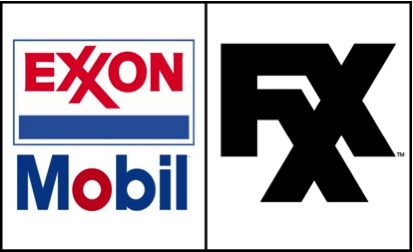Consumers associate a trademark with a familiar experience associated with a specific source. For example, consumers associate the “golden arches” symbol with McDonald’s cheeseburgers and fries. To protect such profitable associations, an owner of a well-known trademark may file for federal registration with the United States Patent and Trademark Office (“USPTO”). USPTO requires the trademark owner, among other things, to police its mark by challenging others who impermissibly copy and use the mark. Therefore, it is not particularly newsworthy that Exxon Mobil Corporation (“Exxon”), an owner of several federally-registered trademarks, brought a complaint against 21st Century Fox et. al. (“Fox”) alleging federal trademark infringement, inter alia. However, Exxon makes an unusual argument that Fox infringed Exxon’s marks by copying the marks’ common “style.”
In September 2013, Fox launched the FXX TV network with a logo featuring a double-X design. Exxon requested that Fox discontinue use of the double-X, but Fox refused. In October 2013, Exxon filed a complaint in the United States District Court, Southern District of Texas claiming that it owns a set of trademarks (“Exxon marks”) with an interlocking double-X, and that Fox’s FXX logo infringes the Exxon marks by using a similar interlocking double-X. Exxon claims that since at least 1967, it has used the “Exxon” emblem and word trademarks, incorporating the double-X, to sell its products and services. Exxon registered the emblem and word marks with the USPTO in 1973 and 2010 respectively. Exxon also claims that since 2000 it has used the interlocking double-X as a standalone trademark on some of its products and services. Exxon registered the stand-alone double-X mark with the USPTO in 2000.
Exxon is unlikely to prevail on its trademark infringement claim. Trademark infringement is the unpermitted use in commerce of another’s mark, which is likely to confuse the public as to the source of the mark. Federal courts generally employ a multi-factor test for “likelihood of confusion.” In a typical infringement suit, a trademark owner claims that an alleged infringer literally or substantially copied the owner’s trademark word or symbol. Here, however, Exxon claims that Fox copied its interlocking double-X “style,” and that copying Exxon’s interlocking double-X style is akin to copying McDonald’s golden arches. To prevail, Exxon would be required to show that the public is likely to be confused by Fox’s use of the double-X. The problem for Exxon is that consumers clearly associate the Exxon marks with gasoline-based products or services, and Fox’s trademarked logos (including FXX) with television and movies. Therefore, even if it is assumed that Fox copied Exxon marks’ style, consumers are unlikely to be confused as to the source of the FXX trademark.
But if Exxon prevails on its infringement claim, then a party could infringe on an existing federal registered mark simply by using a similarly styled mark in commerce, even though the public is unlikely to be confused by the new mark. Such an outcome would be inconsistent with the well-established standard for determining federal trademark infringement.
Image Source: http://www.hollywoodreporter.com/sites/default/files/2013/10/exxon_mobil_logo_fxx_logo.jpg.
